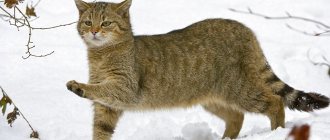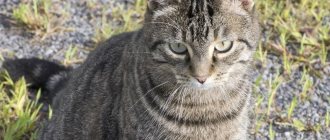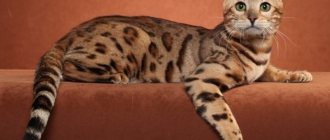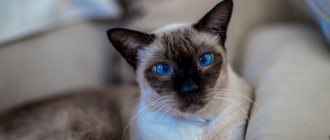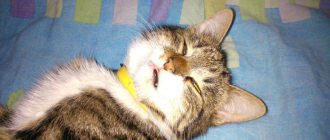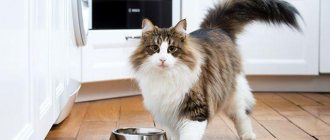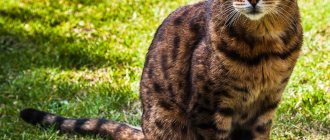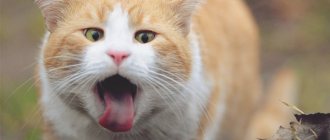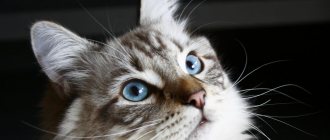History of the origin of the domestic Bengal breed
global $ads_google;
//data-ad-slot=”2475549904″ $ads_google = empty($ads_google) ? false : true; ?> if ($ads_google == false) {?> $ads_google = true; ?> } ?> The goal of breeding the Bengal cat, the founder of the breed, American Jane Mill, considered obtaining a domestic cat that preserved the color of its wild ancestors - this would help focus attention on the serious problem of extermination of leopard cats.
The history of the origin of the Bengal breed began almost 60 years ago, in 1961, when Jane came to Bangkok. This trip became fateful: there she received a baby Asian leopard cat, which is almost impossible to tame. The purchased baby received the name Malaysia and settled down with the new owner. The grown cat gave birth to offspring from a domestic shorthair cat, but the vicissitudes of fate did not allow her to start breeding a new breed.
A new attempt was made by Jane in 1980. She was provided with 9 hybrids of a leopard cat and domestic cats of different breeds. Then Mill fell into the hands of an Indian cat with a golden-orange color, which gave the Bengals a shiny coat called glitter.
The work was long and difficult due to many factors, and ended in success and recognition by the early 90s.
Description of Asian leopard cats
Asian leopards live in the forests and plains of Asia, and in Russia - in the Ussuri taiga. Wild Bengal cats are no different in size from ordinary cats, but they have longer limbs. Body length with tail is 80–100 cm, height at withers 40–41 cm, body weight from 4 to 7 kg. Cats are much larger than cats.
External data
Leopard cats are considered short-haired. Their main color ranges from pale yellow to golden yellow, reddish yellow or gray yellow. Dark spots are scattered across the main background, which can have different sizes and merge into stripes or rosettes on the neck and back of the animal. Often 4 black stripes run from the forehead along the head, which break off on the neck and back and turn into oblong spots. The lower part of the head and body (chin, chest, belly, inner surface of the legs) are always light, almost white, with a spotted pattern.
The body of these small predators is elegant but strong, with a small head and rounded ears.
The head is small in size, the muzzle is short and narrow, with rounded ears of medium height and width. On the dark outer side of the ears there is a white (wild) spot in the center. The eyes are large, the color is yellow, amber, brownish, less often light blue. From the outer corners of the eyes, two pairs of black stripes with a white area between them descend down the head. The nose is large, convex, pink or brick-colored, and the lips are dark.
Characteristic features of this type of wild cat are rounded ears and large round eyes with a dark rim around them.
The body is compact but muscular, with long legs (the hind legs are higher than the front ones) and noticeable webbing between the toes. The tail is approximately half the length of the predator's body, well-furred, covered with spots or stripes, with an obligatory black tip.
The tail of these predators is not very long and often has the shape of a carrot: wide at the base and tapering at the end.
Character
The Asian leopard cat is a solitary cat by nature and communicates with members of its species only during the breeding season and raising kittens. However, when kept in captivity, it gets along well with both its relatives and ordinary cats and dogs. In the wild, she is extremely unsociable, timid, and attacks only as a last resort. He prefers to hide from danger in a safe shelter and watch the events taking place from there. It is difficult to find such a cat in its natural habitat, since it is not only cautious, but also knows how to camouflage perfectly, which is facilitated by its specific color.
If there is a need to protect himself or kittens, then ALC will do this desperately and quite aggressively. Growling, hissing and snorting, as well as claws and teeth will be used. Even small kittens found in the forests and picked up by a person will bite and scratch vigorously until they run out of strength. That is why they need to be tamed from infancy.
ALC react to everything unusual and threatening, from their point of view, with a hiss and then a growl; these animals meow much less often
The wild Bengal cat is very independent, and even being tamed from childhood, does not welcome excessive caresses and stroking from humans, and also does not like to sit in hands. Due to its fearfulness, this animal has low resistance to stress and can easily get sick and die from a mentally traumatic environment - transportation, loud noise, contact with other animals, especially during adolescence (6-7 months from birth).
These predators, being caught at a conscious age for zoos, have a very difficult time enduring the situation of restriction of freedom
Asian leopards are absolutely safe for humans; they can only hiss threateningly if they violate a cat’s personal territory. And the weight category is not the right one to fight a person. Adult ALCs are not domesticated; training them to use a litter tray is almost impossible. They rarely breed in zoos, since the stressful situation of limited freedom negatively affects even the sexual instincts of these predators.
Lifestyle
Wild Bengal cats are predominantly nocturnal. They feel good in any forest: tropical, coniferous, deciduous, as well as in savannah, semi-desert and mountains. They spend the daytime in a den, which they make in hollows or roots of trees, caves, burrows abandoned by other animals, and at night they go out hunting. The best place for a female with kittens to hide is in dense undergrowth, into which large animals and humans cannot penetrate. Asian leopards try in every possible way to avoid humans and stay away from their settlements.
Asian leopard cats are very careful and try to hide in their shelters from all possible dangers, especially from humans.
Leopard cats prefer to settle near rivers and lakes, although they rarely get into water. They can swim and fish, but usually hunt on land. Water prey is turned to in case of severe hunger. The territory of one animal, both male and female, can occupy 2–3 square kilometers. Wild cats mark their areas with urine and excrement. Water serves these predators not only to quench hunger and thirst - they have an interesting habit of urinating, and sometimes defecating, in running water. Most likely, this is due to the desire to hide traces of their presence from potential enemies.
These predators are known as excellent steeplejacks; they move deftly over mountains, rocks, trees and love to attack prey from above
Wild Bengal cats are not only good swimmers, but also excellent climbers. They are excellent climbers and jumpers on mountains, rocks and trees, and love to rest in trees during the day. Hiding in the branches, they hunt birds, squirrels and tree shrews.
Nutrition
Asian leopard cats are exclusively carnivores. Their prey is very diverse: hares, rodents, birds, amphibians, reptiles and even insects. If possible, they will enjoy eating eggs, fish, and green grass, which improves digestion. But the basis of their diet is mice, hamsters and rats, so sometimes cats settle near human houses and effectively hunt mice living on farms. Unfortunately, in doing so, they often destroy chicken coops, which earns them hostility from farmers.
Wild leopard cats are fast and agile hunters. They hunt from ambush, jumping out with lightning speed and biting their prey. ALC does not play with its prey, but holds it with its claws until it dies. Capable of dragging prey in its teeth and hiding it in a secluded place.
Reproduction
In nature, Asian leopards become sexually mature at the age of one and a half years, in captivity much earlier. In the southern regions, leopard cats breed at any time of the year, and in the northern regions - in March-April, when natural conditions allow the cubs to be successfully cared for. If for some reason the kittens from the spring litter die, then the female can bring offspring again, closer to the beginning of autumn.
ALK kittens are born blind, their eyes open after about 10 days
The ALC's pregnancy lasts approximately 9–10 weeks, most often the litter consists of 2–3 kittens. Kittens are born blind, their eyes open only at 10–11 days. After the kittens appear, the male often lives with the female and helps raise the offspring. The cubs do not leave the den for about a month, feeding only on their mother's milk. Starting from the age of one month, they grow fangs that allow them to taste meat food, their weight rapidly increases and they begin to leave their shelter for a short time. Parents bring live prey to the den and teach the kittens to hunt. The female raises the cubs until about 10 months of age, after which they begin independent life.
Lifespan in the wild
The lifespan of Asian leopard cats in the wild is 12–15 years.
Description and standards of Bengal cats
It is impossible not to notice the external features of an exotic cat. Even when very small, the baby Bengal looks like a leopard. An adult Bengal cat receives the highest reviews and, just from one verbal description, is a true beauty.
According to the WCF standard, the breed must have a number of characteristics.
The head is a wedge with a massive chin and thickened chin pads. Thanks to this structural feature, the animal’s muzzle resembles a tiger’s mouth. This similarity is even more noticeable during yawning, meowing or growling.
The ears are short and set high on the head. They are wide at the base and their tips are rounded.
The nose is large, curved and moderately wide.
The eyes are almond-shaped and very beautiful. Eye color is clear green or golden.
The head is located on a thick and strong neck, which is in ideal proportions in relation to both the head and the body.
A cat of this breed has a large body and strong muscles.
Bengals run around the house on round, large and powerful paws. As usual, the length of the hind legs exceeds the length of the front ones.
The tail is medium in size, does not fluff, and is dense to the touch. The domestic leopard's tail has spots or rings.
Bengals are short-haired creatures with a soft, silky coat.
When interested in a description of a particular cat breed, people who are allergic to the Fel D1 protein first of all find out whether this charming creature is a hypoallergenic animal. Despite the fact that shedding almost does not affect these cats, they themselves carry the entire allergen on their skin.
global $ads_google; //data-ad-slot=”2475549904″ $ads_google = empty($ads_google) ? false : true; ?> if ($ads_google == false) {?> $ads_google = true; ?> } ?>
The breed presents a wealth of colors. A popular color is spotted-striped. This variety has shades of gray, white or red.
The most common and characteristic color of the Leopardette breed makes the cat look like a leopard.
“Sorrel” in cats finishes forming closer to the year. The coat is golden, the spots are chocolate brown, and the tip of the tail is black.
A sign of the marbled variety is spots of a peculiar, non-leopard shape.
Cats in white and gray colors are called "snow leopards". Kittens are born white, only later acquiring their characteristic color.
The colors of the Bengal breed also be called: rosette on gold, rosette on silver, marble on gold, marble on silver, seal links point, seal mink, seal sepia, charcoal, blue.
Glitter and phasing in Bengal kittens
Fazing in Bengal kittens is the process when babies from one month to four months are covered with gray or dull white fur. The name of the process comes from the English word fuzzy - unclear, uncertain. When the baby is more than a month old, the owner suddenly notices that the appearance of the young Bengal is changing. His fur becomes strewn with protruding whitish hairs, and the cat looks shaded. If phasing is severe, it makes it very difficult to see the pattern and color of the skin. The full beauty of the fur coat returns to eight months of the animal’s life.
Phasing does not manifest itself in every Bengal kitten.
The breed is characterized by glitter - a particularly strong shine to the coat. This is not a mandatory parameter for exhibitions; you can purchase a cat with or without glitter, since the standard allows both types for all representatives of the breed.
Dimensions and weight of Bengals
When buying such a pet for a home, the owner should imagine how big a Bengal cat grows. The height of an adult animal at the withers is 40-41 cm. The animal grows to this established norm by 1.5 years, but the complete completion of growth processes is completed by the age of two years.
The typical weight of purebred cats is 3.5-5.5 kg. An adult male is more massive than a female and weighs 5-8 kg. Animals of both sexes are larger and smaller than the declared weight, but this does not happen often.
If a cat seems very large and its weight is quite high, this does not mean that obesity has appeared: Bengals are nimble and energetic creatures, and, most likely, their body weight is due to the pet’s excellent physical shape and well-developed muscles.
The body length of an adult handsome leopard is about 90 cm, and the height at the withers is 40-41 cm.
global $ads_google;
//data-ad-slot=”2475549904″ $ads_google = empty($ads_google) ? false : true; ?> if ($ads_google == false) {?> $ads_google = true; ?> } ?> Table of weight of Bengal cats by month
| Age | Female | Male |
| newborn | 65-110 gr | 70-125 gr |
| 1 month | 350-500 gr | 390-560 gr |
| 2 months | 640-1100 gr | 750-1300 gr |
| 3 months | 1.2-1.6 kg | 1.3-2.2 kg |
| 4 months | 1.7-2.6 kg | 2.5-3 kg |
| 5 months | 2.5-3.1 kg | 2.8-4 kg |
| 6 months | 2.8-3.9 kg | 3.1-4.3 kg |
| 8 months | 3.2-4.8 kg | 3.7-5.1 kg |
| 10 months | 3.3-5 kg | 4.3-5.6 kg |
| 1 year | 3.4-5.2 kg | 4.8-6.3 kg |
| 2 years | 3.5-5.5kg | 5-8 kg |
Snow Bengal
Snow color is one of the rare ones. Snow Bengal kittens are divided into three groups depending on their genotype.
Links (Ben n 33) The background is represented by shades of cream or ivory. The pattern varies in tones of brown from light to dark. The head and paws are darker than the body. The tail is brown. These are the only snow bengals that are born completely white, and the pattern does not appear until they are one year old.
Mink (Ben n 32) They are often confused with the link color. The drawing from birth practically merges with the background and is hardly noticeable. The main difference is the eyes: their color varies from bright green to blue.
Sepia (Ben n 31) The color is lighter than golden, but darker than other snow Bengal cats. The difference between the background and the picture is small. The pads on the paws are brown, as is the tip of the tail. Eye colors include variations of green and yellow.
Characteristics of Bengal cats
The appearance of a Bengal kitten in the house expands the horizons of its owners and narrows their horizons to raising one nimble little rascal. The cat's character is bright and memorable: the combination of the natural intelligence of a predator merges with the soft playfulness and sociability of its domestic ancestors.
Reviews about domestic leopards are similar in that these cats are extremely intelligent creatures, so raising and training them is a pleasure. The family favorite remembers commands easily. It doesn't take long to train your Bengal to use the litter box.
The cat’s adaptation to new conditions occurs quickly; very soon the baby will explore all available places and begin to explore forbidden areas. You can compare the character of a Bengal with the character of dogs - he is just as ready to defend his territory, protect his owner, and carry objects from place to place. During the game, the Bengal pet will easily return the abandoned toy, since he himself is interested in spending time with the owner or his child in this way, which is why it is recommended to train the cat.
global $ads_google; //data-ad-slot=”2475549904″ $ads_google = empty($ads_google) ? false : true; ?> if ($ads_google == false) {?> $ads_google = true; ?> } ?>
Cats welcome the company of their beloved household members and are very talkative, but you should not cuddle the animals. Cats are also good with other domestic animals and can make friends with dogs. Bengal girls are well socialized, but they do not approve of communicating with strangers - they need time to understand whether a person entered the house with good intentions.
The animal picks up the mood of its owners very accurately, reacts sensitively to changes in tone of voice, and remembers the words addressed to them.
Raising a cat should start as early as possible. Bengalis are very socialized, they learn understanding and learn about the world from a person's voice. In addition, these cats, like dogs, remember words and are able to follow commands.
They regularly devote time to raising the spotted cat, mainly by playing with the young predator. The game allows the Bengal pussy to show the predatory instincts of a hunter and learn an acceptable behavioral model. Aggressive actions of a cat must be stopped, so it is important to know how to properly raise a cat.
Bengal cats definitely need physical exercise: cats' access to heights is encouraged.
Bengal Color Standards
Any pet, regardless of breed and variety, can have different colors and patterns. The popular spotted and golden leopard skin is not the only color and pattern accepted by felinologists for this breed.
Bengals are domestic versions of their larger jungle cousins. Therefore, this variety has a very wide range of color morphs, shades and patterns.
The genetic origin of both parents in a breeding pair has a strong influence on the result of the crossing; bengals of even the same litter can differ significantly from each other. Fortunately, mapping the feline genome has allowed the genes that control coat, color and pattern in cats to be studied and identified through DNA tests.
Genetic testing allows felinologists to predict the possible outcomes of upcoming litters and can prevent possible diseases at that stage so that they do not become an integral part of the breed.
Strictly speaking, there are only three common color isomorphs acceptable for Bengals:
- brown or gold (brown);
- silver;
- three types of snow (Seal Lynx, Seal Sepia and Seal Mink Point).
Within each color type there are two accepted standard categories - spotted (spotted tabby) and marble (marble).
With so many variations of Bengal cat colors, it is not easy to choose the pet of your dreams.
There are only nine recognized colors of Bengals today. They are given here with spelling in English and generally accepted markings in felinological documents:
- Brown (Black) marbled) BEN 22.
- Seal sepia/Seal mink marbled BEN n 22 31/32.
- Snow marbled/spotted and seal lynx point BEN n 22/24 33.
- Brown (Black) spotted BEN n 24.
- Seal sepia/Seal mink spotted BEN n 24 31/32.
- Brown (Black) silver marbled BEN ns 22.
- Seal sepia/Seal mink silver marbled BEN ns 22 31/32.
- Snow marbled/spotted point and seal lynx point) BEN ns 22/24 33.
- Brown (Black) silver spotted BEN ns 24.
- Seal sepia/Seal mink silver spotted BEN ns 24 31/32.
Although there are already many new colors that are not yet recognized or are experimental. According to some reports, blue colors are already registered with TICA.
With the help of a Bengal color guide, you can determine exactly what a future owner is looking for.
Spotted Tabby or Spotted Rosetted
The spotted colors of Bengals remain the most popular color styles today.
It was the brown spotted tabby cat that was recognized as Champion (TICA) in 1991.
The Bengal tabby has characteristic small to medium-sized spots throughout its coat. Large, random, two-color rosette markings are especially appreciated as they make the pet resemble a miniature Leopard. This reference style arose during a period when breeders considered larger, sparser markings most desirable.
The original spotted tabby colors found in crossbred pets have been modified through long selective breeding.
The animal's coat is covered with random diagonally or horizontally placed markers on the body, abdomen and limbs. Large dark markings on a lightened main background are considered more preferable.
In the spotted type itself, different types of spots are possible on one animal. Even in the brown spotted or rosette type, Bengals can be: red, brown, black, ticked, gray, spotted, rosette, cloudy.
Many people are stunned by the Bengal cat's resemblance to a leopard. Among domestic cats, Bengal markings are perhaps the most diverse and unique.
Single-Spotted
This color means that the markings are monochrome. It is a carpet of solid spots splashed in drops on a lighter background, similar to the markers of wild cats such as Cheetahs or non-hybrid spotted animals of various breeds (Ocicat, Egyptian Mau, Spotted Shorthair or Australian Mist).
Bengals with monochrome spots take part in competitions and cat shows, but they are no longer unique in today's realities. A small number of breeders even express the opinion that they should not participate in competitions. Fortunately, not all felinologists adhere to this point of view, because this wild color is very beautiful.
Rosette Bengal
Of the many spotted Bengal colors among modern breeders, the Rosette Bengal is the most popular today.
Solid markings become rosettes when they are two-tone contrasting prints that are very different from the background shade. Bengal cats are the only domestic breed to be labeled as rosette.
This print only began to appear and develop rapidly in Bengal communities in the early 2000s, when some breeders managed to obtain shaded spots on the background color.
When observing the evolution of the breed over the years, the achievements that the most outstanding breeders managed to achieve when working with the “rosette” in just a couple of decades are especially clearly and surprisingly visible.
There are three main categories of outlets:
- Arrowhead (arrow-head);
- Jaguar paw print (paw-print);
- Donut.
Some of their modifications are also known.
Moreover, according to the Bengal breed standard, the spots or rosettes in the pattern should be aligned horizontally, and not vertically, as in a classic tabby.
Socket type "Arrows" (arrow-head)
The arrow-shaped spots on the Bengal's coat give them a particularly smooth horizontal appearance and create a unique illusory movement.
The arrows are solid and monochrome within the same group of spots, or they can form rosettes with different colors disappearing into the background. Well-defined arrowhead rings are rare and are highly prized by Bengal breeders and owners.
Arrow-type sockets are not the most common, but they are also the easiest to recognize.
The "arrowhead" rosettes have triangular, teardrop-like shapes, all facing toward the animal's back.
The Asian Leopard Cat has many different color forms, but the arrow markings are one of the most striking. Such prints allow the animal to be perfectly camouflaged in the dappled light of a forest habitat, and an animal of this color is very difficult to detect when it is in the trees or among fallen leaves.
Asian cat
Bagel or Donut-socket (donut)
Ring rosettes are markings that are darker than the background color of the Bengal's coat and at the same time highlighted by an even more saturated outline.
They are so called due to a completely or almost completely closed dark ring, in which the center is colored in shades that are at least two to three shades lighter.
It took experienced specialists many years of selective breeding to generate a ring-shaped rosette, but now these prints have remained at the peak of popularity for the second decade and are highly in demand among owners. Some also distinguish this type of markings depending on the size of their outline and overall dimensions. The so-called “pancakes” are described as huge rosettes with thin outlines.
Ring markers have a thicker outline than pancake markers.
Jaguar Pawprint
“Paw print rosette” – shaded markers that are partially open in at least one place, with smaller, more contrasting spots along the edges.
Their peculiarity is that Pawprint is never framed by a thicker and more contrasting surrounding shade.
Resembling the colors of a real Leopard, the Pawprint rosette has rightfully earned its name, as they truly resemble miniature jaguar prints that stretch throughout the Bengal's coat.
Clouded Rosettes
Smoke rings are large, hollow marks that look like a puzzle with little space between the pieces.
This reticulated spotting, reminiscent of the fur of a clouded leopard, is somewhat similar to snake skin.
Chain Rosetting
She describes a series of “donut” or “donut” rings connected horizontally and running along the animal’s spine and parallel to it on both sides.
The “chain rosette” color looks most advantageous and is especially characteristic on such a bright wild cat as Ocelot.
Cluster Rosettes
It is a conglomerate of small spots that form clusters around a lighter color.
Thus, if a person is looking for, for example, the image of a Jaguar, Leopard or Ocelot in a future pet, he needs a color with a rosette.
Marble
Domestic cats have four distinct and heritable coat patterns—ticked, mackerel, multicolor (with spots of other colors), and spotted, all collectively referred to as tabby markings.
The Bengal cat's marbled pattern is derived from the spotted tabby. This pattern is full of swirls, showing distinct markings with sharp edges. A spiral or round (“bull’s-eye”) marker is not desirable. Random pattern and complementary color tones within the pattern are preferred. The animal needs to have patterned markings on its shoulders and colorful markers on its legs and tail. The belly should be spotted.
Christopher Kaelin, a geneticist at the university, conducted a study that was used to identify the tabby and marble alleles in the domestic Bengal cat. Kaelin studied coloration and pattern variations in wild cats in Northern California and was able to identify the gene responsible for the Bengal merle pattern.
The marbled coat pattern is derived from tabby striped prints that curl and curl. An ideal Bengal marble should have horizontally located, but at the same time quite smoothly transitioning into each other, smoothed asymmetric patterned flows, consisting of a swirl of two or more shades. Thus, there are the following four recognized categories of Bengal marble: short swirls in the horizontal plane, the same but longer, chaotic pattern and patterned sheet marble (cloak).
In 1987, Jean Mill produced the first marbled Bengal from her Millwood cattery, Millwood Painted Desert.
Baby Marble was a spectacular little female with a wonderful soft creamy color and unusual print reminiscent of hot caramel splashes. She created a sensation at the competition at Madison Square Garden and throughout America.
The first standard for the Bengal breed from Jean Mill did not provide for anything in the coat pattern except monochrome spots. Painted Desert (the name of the first marble Bengal translates as Painted Desert) had instant recognition from specialists and all the people present at the show; the marbles were subsequently included in the new Bengal standards.
The descendants of these early marbled Bengals provided the genetic material for the first rosettes in the 2000s, and it was their alleles that helped shape the new pattern type.
In 1993, the marbled Bengal received champion status within the TICA.
Sparbled
The beauty of marble color does not end there. An amazing bonus is the fact that in the coloring of a newborn Bengal, the breeder discovers a combination of marbled and spotted patterns.
"Sparbled" is not currently recognized as a separate registered pattern category, but in breeder jargon it is used to describe animals with ring rosettes and marble prints, or tabby cats with marbled markers.
Sparbles are considered to be classified as spotted or rosette tabby in color rather than merle.
Care and feeding of Bengals
A short-haired cat brings less worries at home than its long-haired counterparts, which makes caring for your pet much easier. Keeping and caring for a cat is not difficult: 2-3 times a week, devote a little time to combing the fur, which a soft rubber brush will help with. Sometimes you may not even notice the shedding, but once the procedure has begun, it is better to comb the kitty more often.
The descendant of a wild leopard cat needs to trim its claws once every couple of weeks. The ears are cleaned at the same intervals with a damp cotton pad.
It is also necessary to take care of your pet's oral cavity by brushing its teeth once a week.
The bath easily becomes a favorite place for the Bengal, who happily hits the water with his paws. Washing is allowed in rare cases using special cat shampoos.
Feeding a Bengal kitten occurs from month to month according to the feeding schedule and recommendations of specialists. Good nutrition quickly turns a small cat into a healthy, strong cat.
What to feed a Bengal kitten for 2 months
They also feed raw meat (beef or rabbit), exclude raw offal from the diet, replacing them with boiled sea fish once a week. Dairy products in the form of kefir, baby cottage cheese without any additives, and low-fat cream are useful for cats. The daily food intake also involves the addition of vegetables not exceeding a quarter of the volume of meat products. These are carrots, tomatoes, bell peppers. A Bengal cat can be switched to premium and super premium dry food, which the animals eat with benefit and pleasure.
Keeping a neutered cat involves replacing natural nutrition with specialized food.
Cat care
When choosing a pet, one of the important criteria is the difficulty of care. Cats of the Bengal breed are not whimsical in this regard.
- Their coat is short enough that they do not need daily brushing. It is enough to comb it a couple of times a week with a special brush.
- Nails can be trimmed twice a month, which does not cause any particular difficulties. Ears are cleaned as they become dirty. The procedure is carried out using cotton pads moistened with a small amount of water.
- Dental care is carried out by purchasing special toys or bones. Such things are sold in veterinary pharmacies and stores. They are not expensive and are always on sale.
- They need to be bathed as needed. They love to splash in the water; this is their distinctive feature. Therefore, you definitely won’t have any problems with bathing or scratched hands afterwards.
Otherwise, the requirements are standard, as for any pet. Avoid hypothermia, stay in a stuffy room for a long time, and monitor the quality of food.
The only thing you have to do regularly is play with your pet. By nature they are very active and energetic. They just need to throw out their energy. It is in the owner's interests to ensure that it is directed in the right direction. If you don't play with a Bengal cat, he will do it himself. But then you shouldn’t be surprised by a broken vase or scratches on the furniture.
A great option for these cats is a cottage, with a cat playroom and a huge fenced-in area in the backyard.
Those wishing to have Bengal cats at home should remember that large space is vital for them. Mountains of toys, a sports complex with ladders and tunnels, several scratching posts in different parts of the house, hammocks, houses, separate shelves on the walls that you can jump on all day long.
Bengals are one of those breeds that adore water. Fill them with water in the bath, let them swim in the pool, or at least cool them off in the shower, and they will thank you.
Toilet
They are distinguished by a high level of cleanliness. They wash themselves frequently and bury their toilet thoroughly. Some individuals are so squeamish that they refuse to go into a stale litter box. Therefore, the owner will have to change the tray quite often. You also shouldn’t skimp on filler. You need to choose one that hides the smell well. This way she will think the litter box is fresh. If you choose a cheap filler, she will force you to change it often and the savings will be very dubious.
If the kitten does not go to the tray, but to another place chosen by him, then you can move the toilet there. There are times when it is not possible to move the cat litter to a given location. Then you need to lubricate the area that your cat marked with vinegar. The pungent smell will discourage the desire to misbehave there and eventually the animal will become accustomed to the litter box.
Health of the Bengal cat breed
Fortunately, thanks to breeding work and natural hereditary immunity, Bengal exotic beauties have excellent health indicators. But if their immunity resists most feline diseases, then there are some genetic diseases, the fight against which in many cases is quite successful.
global $ads_google; //data-ad-slot=”2475549904″ $ads_google = empty($ads_google) ? false : true; ?> if ($ads_google == false) {?> $ads_google = true; ?> } ?>
The most common phenomenon is “dry nose syndrome.” This problem can occur in kittens up to one year of age. You can't miss a dry nose: cracks and crusts on the surface of the nose become ulcers. In general, this condition is not critical to health and does not cause any special problems for the animal itself. To know for sure whether a dry nose promises trouble, it is better to consult a veterinarian - it happens that this condition develops into an ulcerative lesion of the nose. The doctor prescribes timely treatment that will help restore the healthy state of the nasal surface.
Bengals are sensitive to poor quality food, so to avoid loose stools, the cat is fed only selected food and always provides the pet with fresh water.
There are two serious genetic disorders: hypertrophic cardiomyopathy (HCM) and flat chest syndrome (FCK) in kittens. In the first case, observations and testing are mandatory; proper care will allow the cat to live a long and good life. The second problem is a serious obstacle to the survival of kittens and is looking for a solution. If a Bengal cat was taken from a cattery with a good reputation, where inbreeding and the use of antibiotics by the pregnant female were not allowed, the problem is unlikely to affect her and her offspring.
Miniature leopards are vaccinated according to a schedule starting at 8 weeks. All vaccinations are prescribed by a veterinarian.
The life expectancy of a healthy Bengal cat is 14-16 years if it lives under the supervision of attentive and caring owners.
If the cat was taken as a family pet, then you need to monitor the onset of puberty in order to castrate or sterilize the animal in time. The first heat in a Bengal cat occurs at 6-8 months, when the female’s weight reaches 2.5-3.3 kg. Cats “grow up” by 9 months. If you want to get offspring from your pet, you need the obligatory assistance of a specialist in breeding, otherwise even a successful mating, healthy pregnancy and problem-free childbirth do not guarantee full-fledged offspring.
Number and protection of Asian leopard cats
In nature, the enemies of the leopard cat are all larger predators than itself, but due to its secrecy and dexterity, it rarely ends up with them for dinner. Unfortunately, the main enemy for this species is humans, who have long hunted the ALC for its beautiful spotted fur. In addition, local residents of Asian regions killed Bengal cats for meat or out of revenge for ruined poultry houses. Poachers have made and are still making their contribution by catching kittens and adult animals for sale to lovers of live exotic animals.
Poachers often catch small wild kittens and pass them off for sale as kittens raised in special nurseries, but such kittens forever remain predators and are not able to adapt to life in a human home
Human activities are actively changing the habitat of Asian leopards, which also contributes to a decrease in their population. ALCs were classified as an endangered species, and certain species, for example, the Far Eastern cat, were listed in the Red Book. In 2006, 169 countries joined the CITES wildlife treaty, which regulates international trade in rare species of flora and fauna. Wild Bengal cat species are included in Appendices 1 and 2 of this agreement as endangered species not subject to trade and species not yet in danger of extinction but whose trade should be limited. Since the agreement was signed in 1973, not a single species listed in CITES has gone extinct. At this time, Asian leopard cats are not considered to be endangered. Nevertheless, these beautiful, independent and fragile predators must be protected.
Buy a Bengal kitten
Nurseries where you can buy a Bengal kitten are quite common in Russia. You won’t be able to save money on buying a descendant of a wild Asian leopard cat if you want to buy a purebred animal that will strictly meet the standards. In the nursery, the buyer will learn all the information about the future cat, its pedigree, and hear interesting facts about the character of the domestic mini-leopard.
The cost of the Bengal remains high precisely because of the difficulties with breeding. The first generation of Bengals will be infertile if they are males. Females of the first generation are crossed with Bengals and a second generation is obtained, where most of the males are sterile. In the third generation from the f2 female, only some males are sterile. The fourth generation are considered true representatives of the Bengal breed, and have a full range of characteristic skills and traits.
The price for a Bengal cat in Russia is:
- pet class
25,000-50,000 rubles; - breed class
50,000-100,000 rubles; - show class from
100,000 rubles
.
What to name a Bengal kitten
When a Bengali boy or girl arrives in the house, the family may have a number of names ready. But before you give the kitten a nickname, you should know that it must begin with the same letter as the name in the passport.
global $ads_google; //data-ad-slot=”2475549904″ $ads_google = empty($ads_google) ? false : true; ?> if ($ads_google == false) {?> $ads_google = true; ?> } ?>
Also, you should not give a new cat the nickname of your previous pet, this is not only a bad omen, but also a careless attitude towards the memory of a deceased or missing pet.
A long name is difficult to pronounce and difficult for a cat to remember. Hissing sounds are welcome, to which the cat will react most quickly. You can experiment and try calling the cat by different names. There is a chance that the animal will choose its own name.
Handy tables have been created with names that might be suitable.
| Girl | Boy | ||
| Julie Dosya Cleo Dotty Shelma Ivy Eva Aida Stesha Fanta Vikki Iksa Yesya Lika Liya | Almira Brandy Toffee Yuni Tori Lynx Klepa Cher Goldie Ulfi Bara Baksa Goldie Lucky Finka | Joshua Joe Alistair Leo Easy Bingo Ike Luntik Wirt Tory Rain Ride Whiskey Martin Ralph | Vince Rick Jacques Mort Indie Byte Drake Knight Spot Fima Gore Chen Zipper Gizmo Weiss |
Life of Asian leopard cats in captivity
Asian leopard cats have a reputation for being wild animals that cannot be domesticated, but this is not entirely true. Indeed, it is very difficult to tame an adult, as well as a young animal (after 3 months), all that remains is to keep it in an enclosure and observe its life and behavior from the outside. However, small kittens, especially those raised by humans, are perfectly tamed and treat people well. Females in captivity often behave inappropriately, constantly dragging their kittens from place to place and they have to be taken away from their mother in order to save their lives. In this case, the cubs are bottle-fed with artificial formulas similar in composition to mother cat milk (dry cat milk, baby food, goat milk), and then gradually transferred to feeding meat. It is these kittens that become the calmest and most devoted pets. But this is difficult and time-consuming work for those people who decide to do it.
Raising small kittens without a mother is hard work, but the positive emotions are off the charts
A simpler option is to give the ALC kittens to be fed and raised by an ordinary domestic cat, whose developed maternal instinct will not allow them to abandon the cubs to their fate. Such kittens can also be successfully kept in houses or apartments as pets. Nurseries usually sell just such babies who grew up with people and domestic cats.
However, owners of leopard cats should take into account that when they reach puberty, their character may deteriorate greatly and their wild nature may fully manifest themselves. Therefore, when keeping ALC at home, it is better to castrate them, and do this in a timely manner - at 7-10 months, then there will be a greater chance of normal behavior in predatory pets.
ALCs are kept in captivity not only as pets, but also as breeders of hybrid kittens. The fact is that it was these wild animals that were used to create the breed of Bengal domestic cats. The breed is popular in many countries of the world, and its representative has been living in the house of the author of this article for 4 years. ALCs successfully mate with domestic cats and produce hybrid offspring. For this purpose, they mainly use ALC cats and ordinary cats, since the female ALC almost never allows a domestic cat to approach her. ALC males are less picky, but they also pay attention to the appearance of their “lady” and prefer spotted cats with a color similar to their own. Therefore, the partner for a wild male most often becomes a domestic cat of the Bengal breed, which has a brownish-golden color. In addition, having become a mother, such a cat takes good care of hybrid kittens and carefully feeds them to the required age. Male kittens from a wild parent of the first and second generation are infertile; only in the third and fourth generation is it possible for fertile males to appear, although this happens quite rarely. Females are fertile and successfully bear offspring. The first generation hybrids are called F1, have an exotic appearance and are the most expensive as pets and for breeding. The price of such a kitten in Russia is from 75 thousand rubles. They are easier to keep than their wild parents, but they also have many features and bring additional problems to the owner. For example, these animals have difficulty learning to use a tray, they often spoil things, carpets and furniture in the apartment, and without a twinge of conscience they steal everything - edible and not so edible.
First generation hybrids from ALC have a softer and friendlier character than their predatory parents, but their behavior is still characterized by savagery and waywardness
As for the more distant descendants of ALC - Bengal cats, these are full-fledged pets, friendly and affectionate, sociable and devoted to their owners. Breeders worked for a long time on their appearance and coloring and as a result they received bright animals with spots or marble stains on the skin and a golden tint to the coat. Bengal cats are very intelligent, inquisitive and funny, and have a completely human look. Distinctive character traits are activity and playfulness at any age, right up to old age, a developed hunting instinct, love of freedom and independence, which is manifested in the fact that it is extremely difficult to hold a Bengal in your arms if he does not want it. This is not just a cat in your house, it is something between a cat and a dog. Bengals are very good at manipulating objects, opening doors and cabinets, are not afraid of water and play with it, and love to walk on a harness and leash (or on their own, but they are usually not given this opportunity). My conclusion: if you like the Asian leopard cat, then get its descendant - the Bengal cat (feline) - in your home. This will save you from many troubles associated with keeping a wild animal in the house, and you will receive a lot of aesthetic pleasure from the beauty of your pet and lively emotions due to its unusual character.
Bengal cats were finally recognized as a separate breed with its own standard in 1991, while hybrids of the F1, F2 and F3 generations are intermediate and are not allowed at exhibitions
Features of care
ALC in captivity will have to be fed exclusively with meat, and not only raw food, but also live food. It is better to give lean meat: beef, veal, rabbit, poultry, as well as chicken necks, offal and sometimes fish. Live food recommended for feeding ALC and many other captive predators - mice, rats, day-old chicks and quail. It must be remembered that by eating a living creature, a cat receives not only animal protein, but also many other useful substances contained in the intestines, skin and entrails of the victim. In addition, by playing with live food, cats satisfy their hunting instincts.
It is enough to feed an adult cat once a day; the daily food intake for the prevention of obesity is approximately 200 grams of meat or 2 mice or 1 rat. If there is no live food in the diet, then you must provide meat with cartilage or chicken necks, paws and heads, as well as vitamin and mineral supplements and fresh grass. Veterinarians recommend giving predators one fasting day a week: completely deprive them of food or, in extreme cases, give them half the daily allowance. In zoos, this practice in feeding predators is common.
It is not recommended to limit the amount of food for pregnant or lactating females or kittens; they are fed 2-3 times a day.
Training ALC kittens to the litter box usually occurs without problems, in approximately the same way as with domestic cats. You just need to take into account the size of the Asian leopard cat, which depends on its variety, and purchase a spacious tray for it, in which it will be convenient to row.
Lifespan
In good conditions, with normal nutrition, physical activity and a comfortable psychological environment, ALCs can live in captivity for up to 20 years. In general, these predators have good health and strong immunity, but psychosomatic disorders are of great importance, when the animal can begin to get sick from boredom and lack of exercise, as well as from dissatisfaction with its hunting instincts. It is very important to regularly vaccinate leopard cats against infectious diseases.
Other Features
Kittens and adult Asian leopard cats love to play hunt and climb. Active behavior comes naturally to them and they need to move around a lot, climb and jump. This lifestyle of a small predator in a person’s home, combined with proper nutrition, will contribute to his health and longevity. It is best to keep adult animals in enclosures with plenty of space and grass, logs and trees, and provide them with the opportunity to hunt for live food. You can also keep them in the yard if you can create obstacles to escape from their owners through the fence.
When keeping an ALC in an apartment, there should be numerous toys, scratching posts and climbing frames so that the cat can occupy itself and not get bored. This applies more to kittens, and adults are sooner or later transferred to an enclosure. If this is not possible, then you should try to take the animals for walks more often.
If it is not possible to keep your home ALC in an outdoor enclosure, then you need to take her for walks regularly
It is necessary to accustom the ALC to hygienic procedures, such as trimming claws, cleaning eyes and ears, combing fur, as well as wearing a harness and leash, from childhood, otherwise the adult cat will actively resist.
Despite the exotic appearance and habits of a predator, ALK is able to play, purr, sleep with the owner and happily communicate with people like an ordinary domestic cat.
Video: Leopard cat: is it really possible to tame it?
Conclusions about the breed
The Bengal cat deservedly receives praise and admiration, but not only due to its chic external characteristics:
- The cat's character is ideal for sociable and sensitive people. Both adults and children can play with the furry baby;
- if the owner does not have time to care for the cat, then it is better to opt for a less demanding breed;
- without experience it is not worth breeding cats;
- a well-developed intellect only pleases;
- the cat does not like to be squeezed;
In general, Bengals have good health and delight with their intelligence.
Photo gallery: Asian leopard cats
The Far Eastern Asian cat is listed in the Red Book
ALC reacts to everything new and unusual with hissing
Asian leopards primarily hunt at dusk and at night, but can also do so during the day.
Far Eastern (Amur) cats live in our country in the taiga in the Far East
The Far Eastern Asian cat has a slightly different skin color, longer hair and close-set small eyes compared to the ALC from the southern regions
Small Asian leopards are just as cheerful and playful as regular cats.
When keeping ALC in enclosures, they try to create an environment close to natural for them - with ponds, trees and, of course, a shelter, heated in winter
Keeping an Asian leopard cat in a city apartment is possible only if the owner has a lot of free time, patience, effort and material costs, and above all, a strong desire to keep a predatory cat from the forest in his home. At the same time, a successful taming result cannot be guaranteed, because such a pet remains a predator whose behavior is based on instincts. It is more expedient to keep ALC in country houses by equipping special enclosures for them. Before purchasing a wild Bengal cat, it will be useful to inquire about the legislation in this area, because in some countries certain types of ALC are protected, and keeping them at home is punishable by law. There are no such prohibitions regarding hybrids of wild and ordinary cats, and the easiest option is to take a closer look at the domestic Bengal breed, whose representatives are no less beautiful than their wild ancestors, but at the same time are much more adequate in communicating with people.
